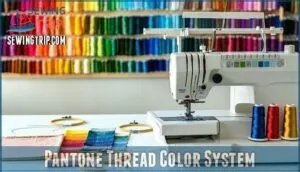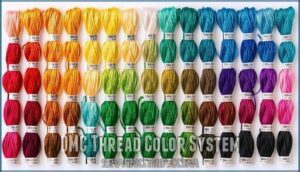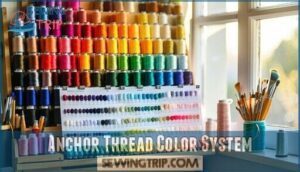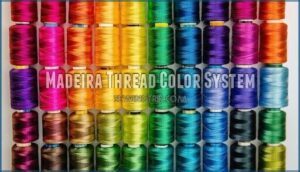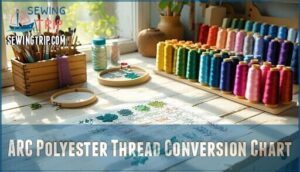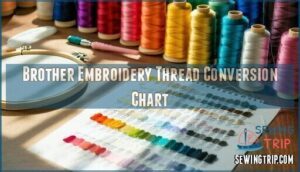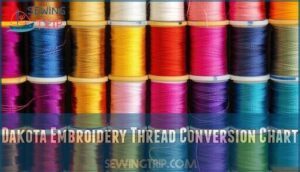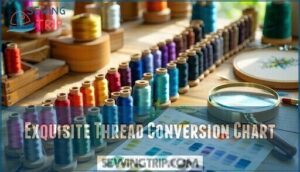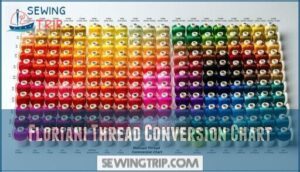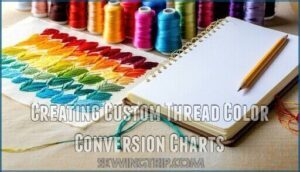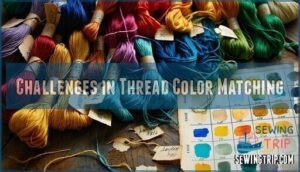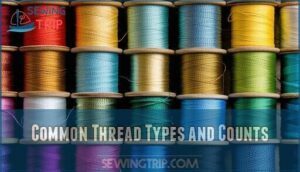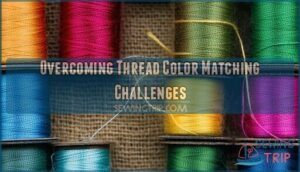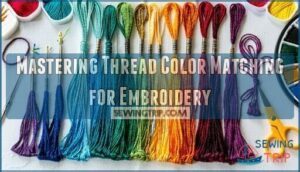This site is supported by our readers. We may earn a commission, at no cost to you, if you purchase through links.
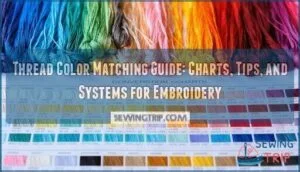 A thread color matching guide helps you find equivalent colors across different embroidery thread brands.
A thread color matching guide helps you find equivalent colors across different embroidery thread brands.
You’ll use conversion charts to match DMC, Anchor, Madeira, and other manufacturer colors when you can’t find the exact shade you need. These charts show color numbers side-by-side, so you can substitute threads without losing your design’s impact.
Digital charts work best since printed versions sometimes show inaccurate colors. Cotton, rayon, and polyester threads each reflect light differently, affecting how colors appear.
Smart embroiderers keep multiple brand charts handy because perfect matches don’t always exist. The real trick lies in understanding why some colors simply can’t be replicated, and this is where a thread color matching guide and conversion charts become essential tools for finding equivalent colors and making perfect matches, and ultimately, to avoid losing your design’s impact.
Table Of Contents
- Key Takeaways
- Thread Color Matching Explained
- Thread Color Systems Used by Manufacturers
- Major Thread Manufacturer Conversion Charts
- Creating Custom Thread Color Conversion Charts
- Challenges in Thread Color Matching
- Common Thread Types and Counts
- Overcoming Thread Color Matching Challenges
- Mastering Thread Color Matching for Embroidery
- Frequently Asked Questions (FAQs)
- Conclusion
Key Takeaways
- You’ll get the most accurate color matches by testing threads under natural light against your actual fabric, since artificial lighting and monitor screens can deceive your eyes and lead to disappointing results.
- Don’t chase perfect matches—slightly darker thread shades typically blend better with your fabric and hide imperfections more effectively than exact color matches or lighter alternatives.
- Keep digital conversion charts for multiple brands (DMC, Anchor, Madeira) handy since they’re more reliable than printed versions, and remember that cotton, rayon, and polyester threads each reflect light differently.
- Create your own custom conversion charts when working with specific thread collections, and always buy extra thread from the same dye lot since colors can vary between production batches.
Thread Color Matching Explained
Matching thread colors might sound simple, but it’s a mix of art and science.
You’ll need to take into account fabric, lighting, and sheen to get that perfect fit for your embroidery projects.
Thread Color Conversion Process
Thread color conversion feels like cracking a code.
Thread matching isn’t just about color—it’s about bringing your creative vision to life with precision.
Use thread color charts or conversion software to find equivalents, but watch for chart limitations.
Metallic conversions and variegated matching can be tricky—test samples under project lighting.
Colors can shift, so double-check matches to avoid surprises.
Software integration helps streamline the process, but reverse-engineering thread charts might be needed for hard-to-find matches.
Remember, no system’s perfect, always test for fabric compatibility and resolve subtle differences before stitching.
Importance of Thread Color Matching
Getting the right colors is like the secret sauce for embroidery.
Perfect thread colors transform ordinary stitches into embroidery magic that stops people in their tracks.
A perfect color match is what gives your designs that flawless, professional finish.
When thread colors are slightly off, though, it’s easy for a polished project to feel less impressive or even mismatched.
Beyond aesthetics, using a thread color matching guide guarantees consistency—a must if you’re stitching company logos or custom designs.
Precision shows your skill, keeps clients happy, and helps you avoid “fix-it” headaches later.
Trust your color charts, but test under natural light to avoid surprises.
Neutrals often work wonders on busy fabrics, blending effortlessly where exact matches seem elusive.
Nail the color matching process, and watch your work leave a lasting mark (no patchy missteps here).
Thread Color Systems Used by Manufacturers
You’ve probably noticed that thread colors don’t always look the same across different brands, and that’s where thread color systems come in handy.
Manufacturers like Pantone, DMC, Anchor, and Madeira use these systems to keep their colors consistent and easy for you to match.
Pantone Thread Color System
In the context of embroidery, Pantone is a game-changer for color accuracy and branding consistency.
Its universal codes simplify matching across brands, making it perfect for intricate designs or corporate logos.
Plus, Pantone aligns with industry adoption trends, bridging gaps in traditional thread color charts.
- Benefits include:
- Reliable branding consistency worldwide.
- Simplified color conversion across thread types.
- Industry-leading standards for color accuracy.
- Strong alignment with future trends in embroidery.
- Trusted tool for precision in high-stakes projects.
DMC Thread Color System
DMC threads are a favorite for embroidery, offering over 500 shades in a clear DMC code system.
Organized by color families, their DMC Color Chart simplifies thread color matching for any project.
From durable six-strand floss to specialty threads, their consistency never disappoints.
Perfect for everything from simple patterns to intricate designs, DMC threads keep your stitches smooth and stunning.
Anchor Thread Color System
Anchor’s thread color system is a standout in any thread color matching guide.
With Anchor Coding and Unique Numbering, it’s easy to find the right shade for your project. The system boasts exceptional Color Accuracy and offers a rich variety of Thread Families, making it perfect for multi-brand color conversion.
Here’s why Anchor shines:
- Precise Thread Color Charts: Never worry about mismatched hues.
- System Features for Clarity: Codes like "Vy Lt" simplify choices.
- Reliable Thread Color Systems: It’s a trusted option for embroidery enthusiasts worldwide.
Madeira Thread Color System
Madeira’s thread color system feels like discovering a rainbow of possibilities. Their vibrant color families simplify finding the perfect match.
With user-friendly thread color charts, you can:
- Pinpoint shades by thread numbers.
- Explore groupings like Polyneon Thread, Rayon Thread, and Metallic Threads.
- Use detailed guides for accurate matching.
- Navigate color conversion with ease.
It’s a thread color matching guide designed for creativity and precision in any embroidery project!
Major Thread Manufacturer Conversion Charts
If you’ve ever struggled to match threads between brands, conversion charts can save the day.
They help you translate colors from one manufacturer to another, making your projects look seamless and professional.
ARC Polyester Thread Conversion Chart
The ARC polyester thread conversion chart is your go-to for seamless color matching, offering reliable alternatives for embroidery projects.
Thanks to RNK Distributing, ARC guarantees chart reliability by providing detailed, updated thread manufacturer conversion charts. It’s ideal for finding equivalents between brands and achieving precise results.
To stay organized, maintain a personal reference sheet. Don’t skip testing colorfastness—it confirms your matches hold up over time.
ARC Accuracy saves time and effort by simplifying polyester alternatives while maintaining consistency.
Here’s a quick breakdown:
| Benefit | Explanation |
|---|---|
| Polyester options | Fits diverse embroidery styles |
| Chart reliability | Guarantees consistent matching |
| Accuracy tested | Supports durable results |
| Easy references | Simplifies brand conversions |
Brother Embroidery Thread Conversion Chart
Thread color conversion doesn’t have to feel like unraveling a mystery. With Brother’s color conversion charts, matching threads to brands like Madeira Equivalents, Sulky Alternatives, or Robison-Anton Options becomes a breeze.
These charts simplify Polyneon and Rayon Conversion, ensuring smooth cross-brand switches. You can find a Brother thread chart for specific needs.
| Feature | Benefit | Example |
|---|---|---|
| Clear numbering | Easy identification | Brother: 001 |
| Reliable conversions | Broader thread options | Matches to DMC |
| Chart compatibility | Seamless substitutions | Sulky, Madeira |
Put these charts to work for stress-free embroidery!
Dakota Embroidery Thread Conversion Chart
When you’re working on embroidery projects, Dakota’s thread color charts make matching a breeze.
Their charts align Dakota, Madeira, Isacord, and Sulky, ensuring accuracy and smooth color conversion.
Users love the chart updates and online access.
For assistance with different brands, you might need thread conversion products.
Here’s a snapshot for reference:
| Dakota | Madeira | Isacord | Sulky |
|---|---|---|---|
| D1001 | 1001 | 0015 | 1001 |
| D1800 | 1800 | 0020 | 1005 |
| D1147 | 1147 | 0108 | 1329 |
| D1025 | 1025 | 1902 | 1246 |
| D2050 | 2050 | 0010 | 1103 |
Exquisite Thread Conversion Chart
Exquisite thread color charts make the thread color conversion process a breeze, especially for matching with major brands like Madeira, Gutermann, or Isacord.
These 40-weight polyester threads, previously called Poly-X40, stand out for their durability and vibrant sheen.
While chart accuracy is solid, outdated charts may cause hiccups. For precise color matching, test on scrap fabric first. Regular chart updates help guarantee reliable results. Reverse engineering can also aid when threads need exact substitutes.
You can find products related to thread color charts online.
| Feature | Details | Pro Tip |
|---|---|---|
| Brand Coverage | Madeira, Isacord, Gutermann | Use updated digital charts |
| Chart Accuracy | High but variable with age | Swatch test before sewing |
| Chart Updates Frequency | Regularly reviewed and improved | Verify latest versions |
Floriani Thread Conversion Chart
Moving from Exquisite’s extensive coverage, Floriani’s thread color conversion charts offer you reliable DMC Conversion paths and Brother Equivalents that won’t let you down.
You’ll find accurate Isacord Options plus stellar Polyester Matching capabilities.
The printed swatches let you test colors before committing, while Chart Updates keep everything current.
| What You Get | Why It Matters |
|---|---|
| Visual swatches | Test matches before buying |
| Online updates | Fresh color options always |
| Multi-brand coverage | One chart, many possibilities |
Creating Custom Thread Color Conversion Charts
When you can’t find the right conversion chart for your thread brands, making your own saves time and prevents color mix-ups.
You’ll create accurate matches by comparing actual thread samples under good lighting, then recording the numbers in a simple spreadsheet or notebook.
Using Embroidery Software for Chart Creation
Creating custom thread color charts with embroidery software can be a game-changer.
Tools like Hatch and ToolShed simplify Software Chart Customization, making personalized matching easier than ever.
Hatch excels with Automated Color Conversion, high Chart Accuracy Validation, and even sharing custom charts among users.
Here’s a quick comparison for you:
| Feature | Hatch Embroidery | ToolShed by DIME |
|---|---|---|
| Custom Charts | Yes | Yes |
| Automated Conversion | Yes | No |
| Chart Accuracy Tools | High | Moderate |
| Color Simulation | Yes | Yes |
| Sharing Options | Yes | Limited |
Keep software compatibility issues in mind, and always test for color accuracy!
Benefits of Custom Thread Color Charts
Once you’ve mastered software-based chart creation, you’ll discover that custom thread color charts offer game-changing advantages.
Think of them as your personal color GPS—guiding you to perfect matches every time.
Personalized Palettes let you curate colors that match your unique style.
You won’t waste time hunting through hundreds of generic options.
Brand Consistency becomes effortless when you organize threads by manufacturer, ensuring seamless project flow.
Cost Savings add up quickly.
You’ll avoid buying duplicate threads and use your existing stash more efficiently.
Enhanced Creativity flourishes when you’re not limited by standard conversion charts.
| Benefit | Impact | Time Saved |
|---|---|---|
| Personalized matching | Perfect color accuracy | 15-30 minutes per project |
| Project Specificity | Customized thread selection | 10-20 minutes setup |
| Design flexibility | Unlimited creative options | Hours of experimentation |
| Inventory tracking | Organized thread management | 5-10 minutes per search |
Custom charts transform chaotic thread collections into organized, accessible resources that boost both efficiency and creativity.
Overcoming Color Inaccuracies in Charts
Custom charts still throw curveballs when colors don’t match reality. Lighting influence plays tricks on your eyes—that perfect blue thread might look purple under fluorescent lights. Monitor calibration affects what you see on screen, making digital charts unreliable for true color accuracy.
Dye lot variance means the same thread number can look different between batches. Brand variance adds another layer of confusion when switching manufacturers.
Here’s your troubleshooting guide:
| Problem | Quick Fix |
|---|---|
| Screen colors look wrong | Adjust monitor calibration settings |
| Thread appears different | Try testing swatches under various lights |
| Charts seem outdated | Download latest chart updates from manufacturers |
Always verify matches with physical threads. Your eyes beat any computer screen for chart accuracy.
Challenges in Thread Color Matching
You’ll discover that matching thread colors isn’t as simple as it looks, especially when your monitor shows one shade but your physical thread appears completely different.
Thread color matching becomes tricky because lighting changes how colors look, dye lots vary between batches, and conversion charts don’t always match what you see in real life, which involves understanding dye lots.
Finding Exact Color Matches
After creating your custom charts, you’ll face the reality that perfect matches don’t always exist. Finding exact thread colors feels like hunting for a needle in a haystack, but smart strategies make it manageable.
Start with reliable color charts and physical swatches. Natural light reveals true colors better than artificial lighting, though cloudy days can throw you off.
Digital tools speed up the process, but monitor settings affect accuracy. Lighting impact and fabric effects change how colors appear, so test threads directly on your material.
When exact matches slip away, blending threads creates custom shades. Darker shades often work better than lighter alternatives for color matching.
Your thread color matching guide should include multiple approaches. Combine physical charts, digital tools, and fabric testing for reliable thread color matching results.
Discrepancies Between Printed and Digital Charts
Your screen shows one color, but your printed chart displays another.
Monitor calibration plays a huge role here – uncalibrated displays can throw off your entire project.
Color profiles between devices rarely match perfectly, creating frustrating gaps.
Lighting influence affects both digital and printed materials differently.
Material variance in paper quality adds another layer of complexity.
Without proper chart updates, you’re working with outdated information.
Always cross-reference digital charts with physical samples under consistent lighting for true color accuracy.
Variations in Thread Shades
Even identical thread numbers don’t guarantee matching colors. Dye lot variance creates subtle differences between production runs, while lighting influence dramatically shifts how you perceive shades. Your workspace fluorescents make threads look completely different than natural sunlight does.
Material effects and fiber differences add another layer of complexity. Cotton absorbs light differently than polyester, affecting shade perception and color saturation. Poor monitor calibration makes digital charts unreliable for thread color variance decisions.
- Dye lot numbers change with each production batch, creating slight color shifts
- Lighting impact varies throughout the day, affecting your color judgment calls
- Material effects cause identical thread colors to appear different on various fabrics
- Fiber differences between cotton, rayon, and polyester alter light reflection patterns
- Shade perception depends heavily on surrounding colors and background contrast levels
Common Thread Types and Counts
You’ll work with three main thread types in embroidery: cotton offers durability and works great with natural fabrics, rayon gives you that silky shine but needs gentle care, and polyester resists fading while handling frequent washing like a champ.
Thread count numbers might seem backwards at first, but remember that lower numbers mean thicker threads, so 30-weight thread is actually thicker than 40-weight thread.
Cotton Embroidery Threads
After tackling matching challenges, let’s explore why cotton threads remain the go-to choice for many embroiderers.
Cotton durability makes these threads perfect workhorses for your projects. They handle frequent washing without breaking down, making them ideal for natural fabrics like linen or canvas.
You’ll love their soft matte finish that adds subtle texture to your work.
Colorfastness tests become your best friend with cotton threads. Hold them under natural light next to your fabric—what you see is what you’ll get after washing. DMC offers over 400 cotton shades with reliable color consistency.
Thread blending works beautifully with cotton since the fibers accept dye evenly. Vintage cotton threads often fade gracefully, creating that coveted antique look.
When checking your thread color chart, remember cotton appears slightly duller than rayon but maintains its embroidery thread colors longer.
For thread color matching, cotton’s predictable behavior makes it forgiving for beginners.
Rayon Embroidery Threads
While cotton offers durability, rayon embroidery thread delivers stunning color vibrancy that makes your projects pop. The distinctive rayon sheen creates a luxurious silky finish that’s hard to beat.
However, this beauty comes with a price – you’ll need proper thread care to maintain stitch quality.
When using thread color charts for thread color matching, rayon’s brilliant embroidery thread colors often appear more saturated than other material alternatives. This makes matching embroidery threads tricky but rewarding.
- Handle gently to prevent breakage during stitching
- Store away from direct sunlight to preserve colors
- Use lower machine tension settings for smooth flow
- Perfect for decorative embroidery requiring extra shine
- Test stitch first on similar fabric scraps
Polyester Embroidery Threads
When tackling tough embroidery projects, polyester thread delivers unmatched Polyester Durability and Colorfast Polyester performance.
This machine embroidery thread resists fading and maintains its Polyester Sheen through countless washes.
Perfect for Polyester Applications like sportswear and children’s clothing, it offers excellent thread color matching consistency.
Blending Polyester threads creates stunning effects while your thread color chart stays accurate project after project.
| Feature | Benefit | Best Use |
|---|---|---|
| UV Resistance | Colors stay vibrant | Outdoor items |
| Wash Durability | Withstands frequent washing | Active wear |
| Color Stability | Consistent thread color matching | Professional work |
Thread Counts and Their Effects
Thread weight numbers work backwards from what you’d expect. Lower numbers mean thicker threads, while higher numbers indicate finer strands. This system affects your embroidery’s visual qualities and stitch quality more than you might think.
- 30-weight threads create bold design texture for statement pieces
- 40-weight offers versatility for most general embroidery projects
- 60-weight provides delicate details on lightweight fabrics
- 80-weight handles intricate work requiring precise thread thickness
- Fabric compatibility improves when matching thread types and counts properly to achieve better results
Overcoming Thread Color Matching Challenges
When color matching challenges turn your embroidery project into a puzzle, you’re not alone.
Lighting effects can make threads look perfect indoors but terrible outside. Monitor calibration issues fool you with false colors on screen—trust physical samples instead.
Fabric impact changes how threads appear; cotton shows colors differently than silk. Dye lot variations sneak in, so buy extra thread upfront.
Check color saturation under natural light, and remember that darker shades often blend better than exact matches for color accuracy.
Mastering Thread Color Matching for Embroidery
You’ve learned the basics, but mastering thread color matching means combining smart techniques with practical testing to get consistent, professional results every time.
The key is using multiple tools together—conversion charts, natural lighting tests, and fabric samples—while remembering that a close match often works better than chasing perfection.
Tips for Effective Thread Color Matching
Natural light becomes your secret weapon for thread color matching success.
Test swatches directly on your actual fabric since lighting impact dramatically changes how colors appear compared to spools.
Master these color matching techniques:
- Fabric considerations matter—match undertones, not just surface colors
- Blending threads often creates better results than seeking perfect matches
- Darker shades typically blend more seamlessly with patterned fabrics
Always verify your thread color selection under various lighting conditions before starting your project.
Importance of Thread Color Accuracy
Getting thread color accuracy right transforms your embroidery from good to exceptional.
When you nail the perfect match, your work screams professional quality and keeps customers coming back for more.
- Project Aesthetics shine when sunset gradients flow seamlessly from orange to deep red
- Brand Consistency builds trust across hundreds of logo reproductions
- Professional Results emerge from invisible seams that disappear into fabric
- Avoiding Mistakes saves you time, money, and client headaches
- Customer Satisfaction soars when nature scenes look authentically realistic
Perfect thread color matching separates hobbyists from pros.
Frequently Asked Questions (FAQs)
How do you match thread colors?
Looking for that perfect match?
Hold your thread against the fabric in natural light.
Test a few strands first, then choose slightly darker shades for best results.
Close matches work fine too.
What colors of thread should I have?
You’ll want basic colors like black, white, navy, beige, and gray for everyday projects.
Add reds, blues, greens, and yellows to cover most needs.
These staples handle about 80% of typical embroidery work.
Should thread be lighter or darker than fabric?
Choose thread one shade darker than your fabric for best results.
Darker thread blends naturally and hides imperfections better than lighter options.
You’ll get cleaner, more professional-looking stitches that won’t stand out awkwardly, with darker thread providing a more seamless appearance.
How to match a thread color?
Hold your fabric next to thread spools under natural light.
Test a few strands against the material since threads look different on spools.
Choose slightly darker shades for better blending—they’ll disappear into your project beautifully.
What color thread should I use?
Match your thread to your fabric’s dominant color or go slightly darker.
Test a few strands against the material under natural light.
When in doubt, choose a shade that complements rather than fights your project’s overall look, to ensure a visually appealing result with natural light.
Should thread color match binding or backing?
Thread color can match either binding or backing – there’s no strict rule.
Consider your fabric’s dominant color, desired contrast level, and overall design aesthetic.
Test both options to see which complements your project best, considering the overall aesthetic.
Does thread color fade after multiple machine washes?
Like parchment scrolls exposed to sunlight, your thread colors will gradually fade with repeated machine washing.
Polyester threads hold their color longer than cotton or rayon, but all threads eventually lose vibrancy over time.
How do seasonal thread collections differ globally?
Seasonal collections vary by region’s climate and cultural preferences.
You’ll find warmer tones dominating autumn releases in temperate zones, while tropical regions emphasize vibrant year-round palettes that reflect local traditions and textile heritage, showcasing cultural preferences.
What affects thread color appearance under different lighting?
Lighting dramatically changes how you’ll see thread colors.
Fluorescent lights make colors look cooler, while incandescent bulbs add warmth.
Natural daylight reveals true colors best, so always test your matches near a window first to ensure the best match.
Should thread colors match both sides of fabric?
You don’t need perfect matches on both fabric sides.
Focus on the visible side where your stitching shows.
The back can be slightly different since it’s hidden and won’t affect your project’s appearance.
Conclusion
Mastering thread color matching isn’t rocket science once you’ve got the right tools in your toolkit.
Your thread color matching guide becomes your best friend when switching between brands or hunting down that perfect shade.
Remember, digital charts beat printed ones every time, and keeping multiple brand conversions handy saves frustration later.
Cotton, rayon, and polyester each have their quirks, so expect some trial and error.
With practice, you’ll nail those color substitutions like a pro.
- https://www.facebook.com/threadbarestitching/
- https://www.pinterest.com/ThreadBareStitching
- https://www.rnkdistributing.com/resources/thread/ThreadConversionChart.pdf
- https://www.brother-usa.com/Virdata/SAPHTMLEditorFiles/5329756EC43812B7E1000000CD8620B8.PDF?_ga=2.147447539.515730047.1660186645-997647510.1658344585&_gl=1*1ao5nq8*_ga*OTk3NjQ3NTEwLjE2NTgzNDQ1ODU.*_ga_NCEW43SJ8W*MTY2MDE4NjY0Ni41LjAuMTY2MDE4NjY0Ni42MA..
- https://help.brother-usa.com/app/answers/detail/a_id/75245/~/thread-color-conversion-chart

